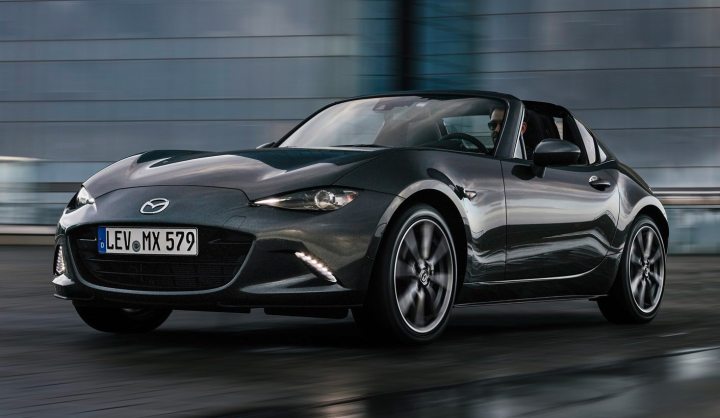Maverick Life, Motoring
Mazda MX-5 RF: When more is less

The latest-generation Mazda MX-5 marks the return of the quintessential, classic roadster: lightweight, lithe and elegantly uncomplicated, with an unwavering focus on undiluted driving pleasure. The RF version adds the convenience of a retractable hard top and an auto gearbox – but loses some lustre in the process. By DEON SCHOEMAN.
When Mazda unveiled the first MX-5 at the 1989 Chicago Motor Show, the Japanese carmaker could not have predicted the impact the small, delightfully uncomplicated roadster would have on the motoring world.

The MX-5 revived a formula that had been the preserve of British marques, including Lotus, Austin Healey and MG, during the 1950s and 1960s, but that had all but disappeared from an increasingly complex and sophisticated automotive arena.
The MX-5 proved that keeping it simple, and focussing on dynamic essentials, could still resonate with a motoring audience hungry for the thrill of an undiluted driving experience.
Ironically, the little two-seater was conceptualised in the US, better known for its larger-than-life, even cantankerous motoring creations. But its popularity soon became a global phenomenon, and sparked a worldwide roadster revival.

Fast-forward 28 years, and the MX-5 is still wooing new fans and pleasing loyal followers. Now in its fourth iteration, this latest model marked a welcome return to the roadster essentials of the original.
It delivers a lighter, nimbler and more engaging form factor than its immediate predecessors, and expresses a renewed focus on establishing a vital rapport between car and driver.

That rapport is epitomised by the concept of jinba attai, which in motoring speak could be interpreted as the art of car and driver becoming one. That may sound a little esoteric, but pilot the current MX-5 and you’ll soon realise that’s exactly what jinba attai actually means.
While the sheer sophistication of modern technology tends to create a disconnect between man and machine, the MX-5 Roadster reacts to driver input with an intuitive precision that’s magical. By the same token, it communicates those reactions with a clarity that creates an instant bond of trust.


The MX-5 Roadster allows you to explore the full extent of its limits, and to find out how close to those limits your own skills reach. Despite the electric power assistance, the steering is lively, translating force, tug and texture with an unwavering honesty that demands dexterous responses.
And since this is no supercar, no 300km/h wondermobile, but a lightweight two-seater with a drivetrain carefully matched to the chassis, you don’t have to drive the MX-5 at a million miles an hour to revel in its capabilities. Even a normal commute at normal speeds is entertaining, simply because you experience the drive so vividly.



Last year Mazda added a second version of the MX-5 to the range. Badged the MX-5 RF (for Retractable Fastback), it’s closely modelled on the standard roadster, but replaces the lightweight, manually operated canvas hood with a retractable hard top that opens and closes at the push of a button.
With the roof in place, the MX-5 is transformed into a fastback coupé, and one could argue that the sleeker roof line creates a more streamlined silhouette than the ragtop roadster.
.jpg)
Stow the roof, and those raked C-pillars remain in place, maintaining the fastback profile, while creating a targa-style open-topper. The result promises a more cocooning cockpit, even if the rush of the slipstream seems equally pronounced at speed.
The roof is the biggest departure from the MX-5 roadster blueprint, but it’s not the only one. In South Africa, it’s offered in conjunction with an automatic transmission only, as opposed to the roadster’s manual gearbox.
Of course, the extra complexity of the roof, and the electric motors needed to raise and lower it, add extra weight. And perhaps acknowledging that the RF is likely to attract a somewhat less adventurous audience, the suspension is softer, the steering not as edgy, and the chassis set-up more forgiving.

All of which transforms the character of the RF quite dramatically when compared to its canvas-hooded sibling, even if the overall dimensions and interior execution are much the same.
The strictly two-seater layout of the RF is identical. The doors open wide to allow easy access, and the leather-clad bucket seats are mounted low, so that the car seems to fold itself around you once ensconced behind the wheel.
The interior design may be inspired by the classic sports cars of yore, but the execution is unashamedly hi-tech. Circular dials ahead of the driver prioritise rev count over speed, but add a digital display with scrollable trip data.
Like the roadster, the RF’s chunky steering wheel gets multifunction controls, and a colour touchscreen display crowns the centre stack. Both models also offer climate control, keyless entry, electric windows, Bluetooth telephony and (optional) navigation. Indeed, neither version could be considered basic.

As for safety, the RF adds adaptive front lighting, lane departure warning and blind spot monitoring to the dual airbags, ABS brakes, stability control, and hill start assist already standard on the roadster.
Hit the start button, and the lusty little 2.0-litre engine bursts into life. At 118kW it’s not nearly in the same power league as the current generation of hot hatches. But then, it only has to propel 1,080kg.
The absence of a turbo is a further boon. It allows a lusty, free-spinning nature that encourages full use of the rev range. All the more’s the pity that the auto transmission doesn’t allow for the swift, incisive gear changes the engine deserves.
Yes, you get shift paddles for quasi-sequential shifting, and a sport mode that sharpens up shift speed and throttle response. But there just isn’t the same intuitiveness, the same snappy, grin-inducing response.
The auto box is slick, and a boon in traffic, but it blunts the dynamic experience when driven with the kind of vigour the MX-5 demands.

The retuned chassis will please some, and disappoint others. It’s certainly more compliant, which benefits ride quality on indifferent surfaces. And it also tames a rear that, in the roadster, can get quite lively when giving it stick.
But I missed the roadster’s keener steering, its more honed responses. In the ragtop, the conversation between car and driver is always challenging and thought-provoking, while the RF’s retorts remain reassuring, but ultimately predictable.
That’s not to say that the RF is boring to drive. Line up a series of twists and turns, and it will scythe its way from apex to apex with unflustered aplomb. Because you sit low in the car, you still feel the Mazda’s every move, even if the softer set-up mutes the feedback.
And while the cockpit is more protected than the roadster’s with the roof down, there’s still more than enough wind in the hair to remind you that the RF is also a convertible. It’s just that the RF strays a little too far from the essence that underpins the MX-5 roadster.
If the fourth-generation ragtop marked a return to the nimble, unequivocal roadster recipe of the original, then the RF is a reminder of how easily successive MX-5 generations diluted driving pleasure for the sake of comfort and convenience.

For now, the MX-5 RF has replaced the roadster on South African roads. The reason, says Mazda SA, is that demand for the ragtop was low, and that it makes sense for only one variant to be offered in order to warrant its presence here at all.
That makes the limited number of fourth-generation MX-5 roadsters that did make it to our shores very collectable – and future classics in the making. I wonder if the same will be said of the MX-5 RF one day? DM
PROS
Head-turning looks and convertible motoring in an elegantly balanced package.
CONS
Lacks the immediacy, the thrills and the engagement of the roadster.
VITAL STATS
| Mazda MX-5 RF | |
| In-line four cylinder, 1,998cc, turbo | |
| Power | 118kW @ 6,000rpm |
| Torque | 200Nm @ 4,600rpm |
| Power-to-weight ratio | 109.3 kW/ton |
| Gearbox | Six-speed automatic, RWD |
| Wheels/tyres | 17-inch alloy, 245/45 R17 tyres |
| 0-100 km/h | 8.6sec |
| Top speed | |
| Fuel tank capacity | Engine |
| Fuel consumption (claimed/tested) | 6.7 / 9.8 litres/100km |
| Operating range (claimed/tested) | 672 / 416km |
| CO2 emissions | 156 g/km |
| Retail price/as tested | R532,800 |

















 Become an Insider
Become an Insider